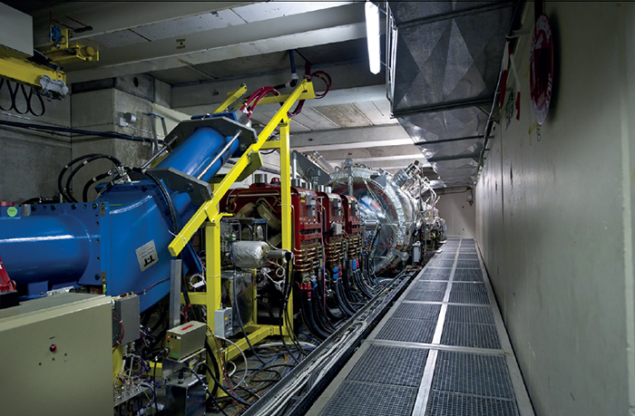
Image credit: CERN-EX-1105131-13.
Antiprotons returned to CERN’s Antiproton Decelerator (AD) on 5 August and experiments have been receiving beams since mid-September, following an intensive consolidation programme during the first long shutdown (LS1) of the accelerator complex. Work has involved some of the most vital parts of the decelerator, such as the target area, the ring magnets, the stochastic cooling system, vacuum system, control system and various aspects of the instrumentation.
The AD uses antiprotons produced by directing the 26 GeV/c proton beam extracted from the Proton Synchrotron (PS) onto an iridium target. In the AD target area, these antiprotons are produced, collimated and momentum-selected to prepare for their injection into the decelerator, where their energy is reduced to the level requested by the experiments.
Although the AD started operations for the antimatter programme in 2000, it reuses almost entirely the components and configuration of an older machine – the Antiproton Collector (AC) – built in 1986. When the AC was designed, the target area needed a high repetition rate of one proton pulse every 2.4 s. Now, the AD’s repetition rate is just 90 s, so components wear out more slowly. Nevertheless, at the beginning of LS1 a problem was found in the transmission line for the electric pulse that goes into the magnetic horn – the device invented by Nobel laureate Simon van der Meer that focusses the diverging antiproton beam. As well as this, after 20 years of operation, the magnetic horn itself had been severely damaged by electric arcs.

Image credit: Tommy Eriksson.
The LS1 programme, involving teams of specialists from CERN’s technology, engineering and beam departments, replaced the transmission line and magnetic horn. The horn assembly is composed of three main parts: the horn itself, which consists of two concentric aluminium conductors, a 6-m-long aluminium strip line that carries the current from the generators to the horn, and a movable clamping system that ensures the electrical continuity between the horn and the stripline. Given the critical situation, the teams decided to replace all three components. They had only six months to re-assemble and test spares more than 20 years old, and to construct additional pieces. The consolidated system was assembled and tested on the surface before being installed underground in the target area.
While repairing the damaged components, the teams also examined the 20-tonne dipole magnets. One magnet was removed from the ring and opened up for the first time in 30 years. The coils were in good condition, but the shimming that holds the coils had been completely transformed into dust and needed repair.
The consolidation work on the AD was completed at the end of July, and the first beam was sent to the target on 5 August. Debugging, adjustments and fine tuning were then carried out to deliver antiproton beams to the experiments in mid-September. The work also included the installation of a brand-new beam line for the new Baryon Antibaryon Symmetry Experiment (BASE) experiment, which aims to take ultra-high-precision measurements of the antiproton magnetic moment. The programme has been prompted by the start of the Extra Low ENergy Antiproton ring (ELENA) project. Planned to be operational in 2017, ELENA will allow further deceleration, together with beam cooling of the antiprotons, resulting in an increased number of particles trapped downstream in the experiments.
Elsewhere at CERN, 12 September saw the Super Proton Synchrotron accelerate its first proton beam after LS1. At the LHC, work continues towards the restart. Of the eight sectors, sector 6-7 is the first to have been cooled down to its nominal temperature of 1.9 K. The first powering tests began there on 15 September. Five other sectors were in the process of being cooled during September, with the seventh on track to begin its cool down in early October. All sectors are first cooled to 20 K for the copper-stabilizer continuity measurement tests, which allow the performance of the circuits to be checked when they are not superconducting. The finish line is in sight for the LHC’s restart in spring 2015.







